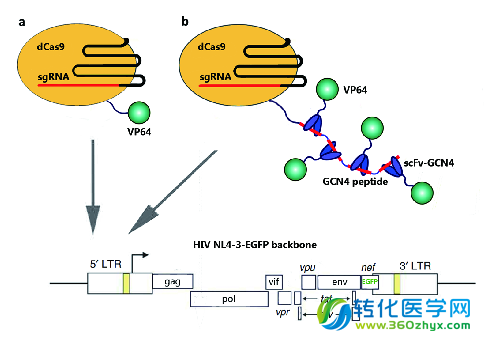复旦大学朱焕章课题组利用CAS9技术靶向干预HIV潜伏
| 导读 | 近日,复旦大学生命科学学院遗传工程国家重点实验室朱焕章课题组利用CAS9技术在体外靶向干预HIV潜伏取得进展,为艾滋的功能治愈迈出了关键一步。该文发表在国际基因治疗领域著名杂志Mol Ther. (1区)2016 Jan 18. doi: 10.1038/mt.2016.7在线发表(http://www.ncbi.nlm.nih.gov/pubmed/26775808),相关工作亦已申请了中国专利。 |
艾滋病,即人类免疫缺陷病毒(HIV)感染人体后造成的免疫缺陷疾病。自从上世纪发现以来,HIV在全球快速传播。截止2015年,全球共有4300万艾滋病患者。目前,国际上已有近30种抗逆转录病毒药物应用于艾滋病的临床治疗,然而,现有这些药物只能抑制病毒复制,不能清除艾滋病病毒(HIV)感染, 其原因主要在于HIV可潜伏于少数免疫细胞,特别是CD4+T细胞,以此逃脱了机体免疫系统和抗病毒药物攻击。因此,研发能靶向干预HIV潜伏的新型治疗技术,已成为目前国际上艾滋病治愈研究领域发展趋势和研究的焦点。
但是,研究者认为,尽管在体外细胞模型上证实了“引蛇出洞”策略的有效性,倘若使该策略应用到临床还有一段距离。
近几年来,朱焕章课题组在艾滋病基因治疗新型策略研究方面取得了阶段性的研究进展。2013年,首次提出并在体外证实利用基因编辑技术靶向切除整合HIV前病毒的“斩草除根”的AIDS/HIV治疗策略的可行性(Nucleic Acids Res,2013;41(16):7771-82);2014年,又获得了能特异靶向HIV调控区的锌指转录因子(ZFP)及转录样因子(TALE)融合基因,并在潜伏细胞模型上证实了这些融合蛋白可靶向激活潜伏HIV表达(Gene Therapy ,2014,21,90-95;AIDS Res Hum Retroviruses,2015,31:98-106)。本文是转化医学网原创内容,转载请点击获取授权
Mol Ther. 2016 Jan 18. doi: 10.1038/mt.2016.7. [Epub ahead of print]
Specific reactivation of latent HIV-1 by dCas9-SunTag-VP64-mediated guide RNA targeting the HIV-1 promoter.
Ji H, Jiang Z, Lu P, Ma L, Li C, Pan H1, Fu Z, Qu X, Wang P, Deng J, Yang X, Wang J, Zhu H.
Abstract
HIV-1 escapes antiretroviral agents by integrating into the host DNA and forming a latent transcriptionally silent HIV-1 provirus. Transcriptional activation is prerequisite for reactivation and the eradication of latent HIV-1 proviruses. dCas9-SunTag-VP64 transcriptional system has been reported that it can robustly activate the expression of an endogenous gene using a single guide RNA (sgRNA). Here, we systematically investigated the potential of dCas9-SunTag-VP64 with the designed sgRNAs for reactivating latent HIV-1. We found dCas9-SunTag-VP64 with sgRNA 4 or sgRNA 5 targeted from -164 to -146 bp or -124 to -106 bp upstream of the transcription start sites of HIV-1 could induce high expression of luciferase reporter gene after screening of sgRNAs targeting different regions of the HIV- 1 promoter. Further, we confirmed that dCas9-SunTag-VP64 with sgRNA 4 or sgRNA 5 can effectively reactivate latent HIV-1 transcription in several latently infected human T cell lines. Moreover, we confirmed that the reactivation of latent HIV-1 by dCas9-SunTag-VP64 with the designed sgRNA occurred through specific binding to the HIV-1 LTR promoter without genotoxicity and global T cell activation. Taken together, our data demonstrated dCas9-SunTag-VP64 system can effectively and specifically reactivate latent HIV-1 transcription, suggesting that this strategy could offer a novel approach to anti-HIV-1 latency.(转化医学网360zhyx.com)
而基因编辑技术则是人类调控基因表达的重要工具,现已有多个利用基因编辑技术的临床试验方案已被美国FDA批准,并应用到病人的抗肿瘤或艾滋病的基因治疗研究。本文研究者提出了利用最新的基因编辑技术CRISPR/Cas9,靶向激活潜伏HIV前病毒的“引蛇出洞”的策略。

但是,研究者认为,尽管在体外细胞模型上证实了“引蛇出洞”策略的有效性,倘若使该策略应用到临床还有一段距离。
近几年来,朱焕章课题组在艾滋病基因治疗新型策略研究方面取得了阶段性的研究进展。2013年,首次提出并在体外证实利用基因编辑技术靶向切除整合HIV前病毒的“斩草除根”的AIDS/HIV治疗策略的可行性(Nucleic Acids Res,2013;41(16):7771-82);2014年,又获得了能特异靶向HIV调控区的锌指转录因子(ZFP)及转录样因子(TALE)融合基因,并在潜伏细胞模型上证实了这些融合蛋白可靶向激活潜伏HIV表达(Gene Therapy ,2014,21,90-95;AIDS Res Hum Retroviruses,2015,31:98-106)。本文是转化医学网原创内容,转载请点击获取授权
Mol Ther. 2016 Jan 18. doi: 10.1038/mt.2016.7. [Epub ahead of print]
Specific reactivation of latent HIV-1 by dCas9-SunTag-VP64-mediated guide RNA targeting the HIV-1 promoter.
Ji H, Jiang Z, Lu P, Ma L, Li C, Pan H1, Fu Z, Qu X, Wang P, Deng J, Yang X, Wang J, Zhu H.
Abstract
HIV-1 escapes antiretroviral agents by integrating into the host DNA and forming a latent transcriptionally silent HIV-1 provirus. Transcriptional activation is prerequisite for reactivation and the eradication of latent HIV-1 proviruses. dCas9-SunTag-VP64 transcriptional system has been reported that it can robustly activate the expression of an endogenous gene using a single guide RNA (sgRNA). Here, we systematically investigated the potential of dCas9-SunTag-VP64 with the designed sgRNAs for reactivating latent HIV-1. We found dCas9-SunTag-VP64 with sgRNA 4 or sgRNA 5 targeted from -164 to -146 bp or -124 to -106 bp upstream of the transcription start sites of HIV-1 could induce high expression of luciferase reporter gene after screening of sgRNAs targeting different regions of the HIV- 1 promoter. Further, we confirmed that dCas9-SunTag-VP64 with sgRNA 4 or sgRNA 5 can effectively reactivate latent HIV-1 transcription in several latently infected human T cell lines. Moreover, we confirmed that the reactivation of latent HIV-1 by dCas9-SunTag-VP64 with the designed sgRNA occurred through specific binding to the HIV-1 LTR promoter without genotoxicity and global T cell activation. Taken together, our data demonstrated dCas9-SunTag-VP64 system can effectively and specifically reactivate latent HIV-1 transcription, suggesting that this strategy could offer a novel approach to anti-HIV-1 latency.(转化医学网360zhyx.com)

评论:
共有 1 条评论
-
 游客2016-01-21 16:31:11这么吊!
游客2016-01-21 16:31:11这么吊!
加载更多
 正在加载
正在加载没有更早的了
 腾讯登录
腾讯登录